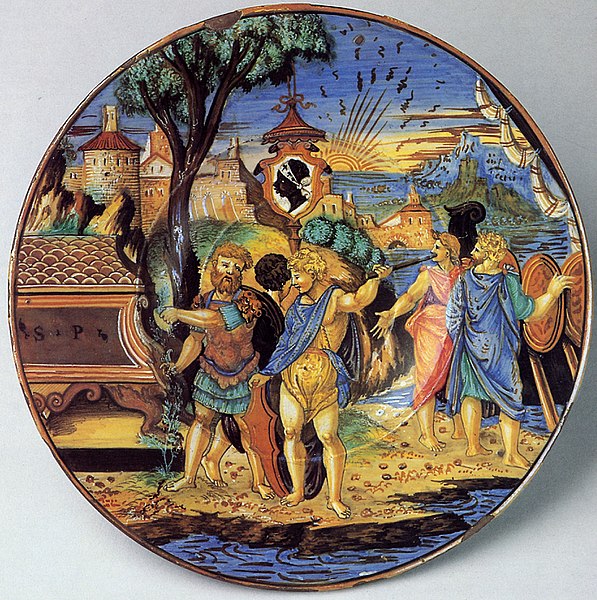If you’re a fan of Greek mythology, you’ve probably heard of the Trojan hero Aeneas, a man of unwavering piety and indomitable will. But there’s so much more to his story than most people realize.
Aeneas Key Facts
| Parents | Anchises and Aphrodite |
| Partners | Creusa, Dido, Lavinia |
| Siblings | None |
| Offspring | Ascanius (Iulus) |
| Other Names | None |
| Roman Name | Aeneas |
| Best Known Myth | The Aeneid |
Name and Etymology
The name Aeneas likely derives from the Greek word “ainein,” which means “to praise.” A fitting name for a man who would go on to receive endless accolades in both Greek and Roman mythology. In Rome, he’s known by the same name, Aeneas, a testament to his enduring legacy across cultures.
His epithets are fewer than those of other heroes or gods, but they are no less significant. One such title is “Pius Aeneas,” emphasizing his piety and devotion to the gods and his family. While he doesn’t have many other names, the ones he does have are deeply meaningful and reflect the core aspects of his character.
In Roman mythology, Aeneas holds a special place as the progenitor of the Roman people. His story is chronicled in Virgil’s epic, “The Aeneid.” There he is portrayed as a man destined to escape the fall of Troy and establish a new home in Italy, thereby laying the foundations for the Roman Empire.

Family and Relationships
Born to Anchises, a mortal, and Aphrodite, the goddess of love, Aeneas had a rather extraordinary lineage. His birth was the result of a divine scheme, as Zeus wanted to humble Aphrodite by making her fall in love with a mortal. Anchises was that lucky—or perhaps unlucky—man, depending on how you look at it.
Aeneas’ childhood is shrouded in mystery, but what we do know is that he was raised to be a warrior. He was taught the arts of war and governance, skills that would serve him well in his later life. His upbringing was likely a blend of mortal and divine influences, given his unique parentage.
As for romantic entanglements, Aeneas had his fair share. His first wife, Creusa, bore him a son, Ascanius. Later, during his wanderings, he would fall in love with Dido, Queen of Carthage, a relationship that ended in tragedy. Finally, he married Lavinia in Italy, fulfilling his destiny to become the founder of a new nation.
Aeneas Games
Do you want to test your knowledge about Aeneas and other Greek heroes? Play this game:
Don’t forget to try our other games as well!
Myths about Aeneas
The myths surrounding Aeneas are as intricate as they are captivating. Offering a panoramic view of a hero’s journey fraught with trials, tribulations, and divine interventions. Let’s delve deeper into some of the most pivotal moments that shaped this Trojan hero’s destiny.
The Fall of Troy
Aeneas was a stalwart defender of Troy, fighting alongside heroes like Hector against the Greek onslaught. When the city finally succumbed to the cunning Greek stratagem involving the infamous wooden horse, He found himself in a unique position. Guided by a dream from Hector’s ghost, he realized his role was not to die gloriously in battle but to lead the remnants of his people to a new homeland. The image of Aeneas carrying his father Anchises on his back while holding his son Ascanius’ hand is one of the most enduring in all of mythology.
The Odyssey to Carthage
After the fall of Troy, Aeneas and his band of survivors set sail in search of a new home. Their journey was anything but smooth; they encountered numerous obstacles, including a run-in with the Harpies, The Winged Spirits—foul creatures part bird, part woman—and a sojourn on the Strophades Islands. Eventually, they landed in Carthage, where Aeneas met and fell in love with its queen, Dido. Their love affair was passionate but short-lived; guided by a message from Zeus (Jupiter), Aeneas realized he had to leave to fulfill his destiny. The heartbroken Dido committed suicide, cursing Aeneas and his descendants.
The Underworld and the Prophecy
One of the most mystical segments of Aeneas’ journey was his descent into the Underworld, guided by the Cumaean Sibyl. Here, he met the spirit of his father, Anchises, who revealed a grand prophecy: Aeneas would go on to found a great city that would become Rome, and his descendants would rule the world. This prophecy reinvigorated Aeneas, giving him the strength to continue his quest despite the overwhelming odds.
The Arrival in Italy and the Latin War
Upon reaching Italy, Aeneas faced yet another set of challenges. He had to contend with Turnus, the Rutulian king who opposed his arrival and sought the hand of Lavinia, whom Aeneas was destined to marry. A series of battles ensued, known as the Latin War. Aeneas was aided by the Tiber River god and even received a shield from Hephaestus, depicting scenes of Rome’s future glory. After a fierce duel, Aeneas kills Turnus, securing his place in Italy and paving the way for the founding of Rome.
The Foundation of Rome
After the defeat of Turnus, Aeneas married Lavinia, and together they founded Lavinium, named after the queen. This city would later give birth to Alba Longa, from which Romulus and Remus, the founders of Rome, would emerge. Thus, Aeneas’ legacy was cemented, not just as a hero who survived the fall of Troy, but as the progenitor of a new civilization that would one day conquer the known world.
So, as you can see, the myths surrounding Aeneas are not just tales of heroism and adventure; they are foundational narratives that explain the origins of a people and a culture. From his escape from the smoldering ruins of Troy to his epic battles in Italy, every step of Aeneas’ journey was guided by fate, divine intervention, and an unwavering commitment to his destiny.
Depiction And Characteristics
Aeneas is often depicted as a strong, bearded man, wearing armor and carrying a shield. His shield, crafted by Hephaestus, is one of his most famous symbols; it depicts scenes from the future history of Rome. This shield serves as a constant reminder of his destiny and the weight of his responsibilities.
In terms of personality, Aeneas is complex. He’s dutiful and pious, always striving to fulfill the will of the gods, even when it conflicts with his own desires. His sense of duty often puts him in difficult situations, forcing him to make painful choices.
Animals or plants associated with Aeneas are not as prevalent as with other mythological figures. However, the laurel tree, a symbol of victory and honor, could be loosely associated with him, given his ultimate triumph in Italy.

Representations Of Aeneas In Art
Aeneas has been a popular subject in art, especially during the Renaissance. One of the most famous depictions is the “Aeneas, Anchises, and Ascanius.” Made by Gian Lorenzo Bernini, the sculpture captures the hero’s strength and piety as he rescues his family from Troy.
Another notable artwork is Federico Barocci’s “Aeneas’ Flight from Troy,” which portrays the emotional intensity of the moment Aeneas leaves his fallen city. The painting captures the hero’s sorrow and determination, encapsulating the dual nature of his character.
In modern times, Aeneas continues to inspire artists and writers alike, serving as a symbol of resilience, duty, and the complexities of human emotion.
Mentions in Ancient Texts
First and foremost is Virgil’s “The Aeneid,” penned around 29–19 BCE. Virgil was a Roman poet born in a village near Mantua in Cisalpine Gaul (modern-day Northern Italy). His epic serves as both a sequel to Homer’s works and a mythological prelude to the history of Rome. In this text, Aeneas is portrayed as a man of destiny, with phrases like “Fate demands it” underscoring his role in the grand scheme of things.
Next, we have Homer’s “Iliad,” written in the 8th century BCE. Homer, an ancient Greek poet traditionally said to be from Ionia, offers one of the earliest portrayals of Aeneas. Although he’s not the central figure in the “Iliad,” Aeneas stands out as a valiant Trojan warrior. He is holding his own among legends like Hector and Achilles, The Mightiest Champion of The Trojan War. His role in this epic sets the stage for his later adventures and provides a glimpse into his character.
Ovid’s “Metamorphoses,” written in 8 CE, offers another lens through which to view Aeneas. Ovid was a Roman poet born in Sulmo (modern-day Sulmona, Italy). In this text, Aeneas is portrayed in a more human light, focusing on his vulnerabilities and complexities. While not the central figure, his presence enriches the tapestry of mythological characters and events that Ovid weaves.
Last but not least is Quintus of Smyrna’s “Posthomerica,” penned in the 4th century CE. Quintus was a Greek epic poet from Smyrna, in Ionia (now İzmir, Turkey). His work fills in the gaps left by Homer’s “Iliad,” offering a more detailed account of Aeneas’ exploits during the Trojan War. This text is maybe less renowned than the others. However, it provides valuable insights into Aeneas’ role in the fall of Troy and his subsequent journey.
Frequently Asked Questions
Aeneas was a valiant Trojan warrior who fought alongside Hector. After the fall of Troy, he led a group of survivors to find a new home, eventually founding Rome.
He was the son of Anchises, a mortal, and Aphrodite, the goddess of love.
His most famous myth is chronicled in Virgil’s “The Aeneid,” where he is portrayed as the founder of Rome.
Yes, he appears in Homer’s “Iliad,” Ovid’s “Metamorphoses,” and Quintus of Smyrna’s “Posthomerica.”
His Roman name is the same as his Greek name, Aeneas, a testament to his enduring legacy across cultures.
Featured Image Credit: Federico Barocci, Public domain, via Wikimedia Commons

